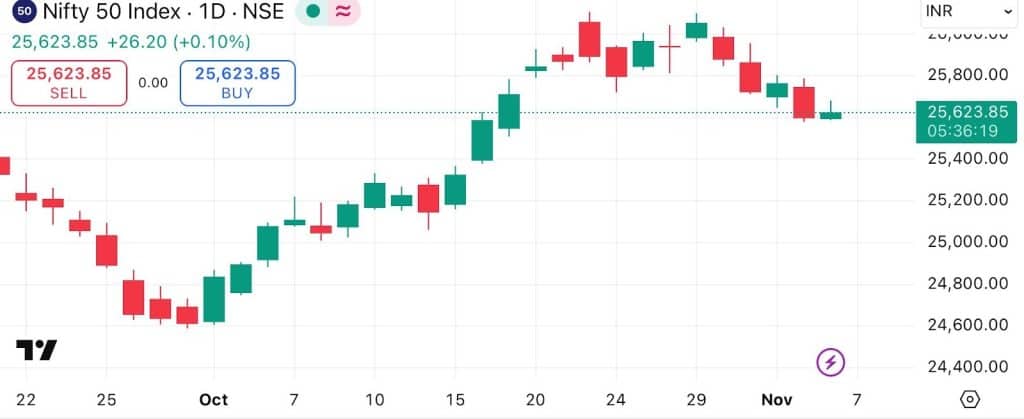
Losses in option trading can pile up faster than expected. One wrong position, poor timing, or lack of discipline can quickly erode capital. This isn’t rare. An updated SEBI study (FY22–FY24) found that 93% of individual traders in equity F&O incurred losses, amounting to over ₹1.8 lakh crore in just three years. Such numbers display the need for a structured way forward. In this blog, we’ll discuss how to recover loss in option trading through practical methods focused on control, strategy, and rebuilding.
Understanding Option Trading Losses
Options trading comprises the process of buying and selling contracts that derive their value from an underlying asset. Losses can occur for several reasons. A common reason is choosing a strategy that does not match the market’s current direction.
For example, using a bullish (upward) strategy when the market is moving downward can lead to a loss. Other factors include not setting a clear exit point, which might let a small loss turn into a large one. Holding a position for too long until the option’s time value runs out can also result in a loss, as options have a set expiration date.
Strategies to Recover from Losses in Option Trading
When a trader experiences a loss, there are several methods that can be considered, as follows:
- Analyse past trades
The first step is to review what went wrong. Look at trade logs to identify patterns or repeated errors. Understanding the reasons for a loss, whether it was a poor entry, holding on too long, or market volatility, is key. This analysis helps refine the trading approach for the future.
- Adjust position sizing
This refers to deciding how much capital to use for each trade. Using a smaller portion of the total portfolio for any single trade can reduce the impact of a loss. It prevents one bad trade from causing significant damage to the account.
- Use stop-loss orders
A stop-loss order is an instruction to sell an option if it reaches a certain price. This is a simple tool to pre-define the maximum loss one is willing to take on a trade, helping to remove emotion from the exit decision.
- Use risk-limited strategies
Certain option strategies, like vertical spreads or iron condors, have a built-in, limited risk. The maximum possible loss is known from the start, which can help manage potential downsides compared to strategies with unlimited risk.
- Monitor and adjust
It’s important to keep an eye on active trades. Market conditions change, and a trade may need to be adjusted or closed early, even if it hasn’t hit a stop-loss. This requires a clear plan for what to do if a trade is not working out.
- Take a trading break
After a significant loss or a string of losses, it can be useful to pause trading. This provides a break from the emotional pressure and allows time to re-evaluate strategies without the stress of being in the market.
- Avoid speculation
Making trades based on emotion, guesses, or rumors is a form of speculation. Decisions should be based on a clear strategy and careful analysis.
- Maintain trade logs
Writing down every trade, including the reason for it, the entry price, the exit price, and the result, is very helpful. Reviewing these logs provides insights for improvement and is a core part of learning from experience.
Figuring out how to recover loss in option trading often involves using a combination of these disciplined techniques.
For example, based on the chart below, a trader might have bought a NIFTY call option in late October, expecting the price to continue rising past 25,900. When the market reversed and fell to 25,623.85, that position would be at a loss.
If the trader had used a stop-loss order, their position would have automatically closed at a pre-set level (like 25,800), resulting in a small, defined loss. Similarly, a trader who was monitoring and adjusting might have seen the first large red candle as a sign to exit the trade manually.

Taking these steps would have prevented a small, manageable loss from turning into a much larger one.
Risk Management Techniques of Options Trading
Managing risk is a central part of options trading. Several techniques can be used, which include:
- Education: A complete understanding of how options work is the first step. This includes learning how their prices are set, what factors affect them (like time decay and volatility), and the specific risks involved with different strategies.
- Diversification: This means spreading investments across different assets, sectors, or strategies. It helps reduce the risk of having too much exposure to one single stock or one type of market move. If one position loses value, others may not be affected in the same way.
- Risk capital allocation: A trader can decide on a specific amount of money, or “risk capital,” that is set aside just for trading. This is money that one can afford to lose without impacting their overall financial stability. This helps limit the impact of worst-case scenarios.
- Hedging strategies: Hedging involves using other options or assets to offset potential losses in a current position. It’s like a form of insurance. For example, a trader might buy a put option to protect a stock position from a price drop.
- Have a trading strategy: Trading without a plan can lead to random results. A clear strategy defines objective criteria for when to enter a trade, when to exit (both for profit), and, most importantly, when to cut a loss.
- Maintain discipline: Once a strategy and risk limits are set, discipline is needed to stick to them. This means avoiding impulsive decisions and not holding on to losing trades in the hope they will turn around.
- Understand technical indicators: Factors like the “Greeks” (delta, vega, theta) describe how an option’s price might change. Understanding these technical points helps in making more informed decisions.
- Account for volatility: Volatility, or how much an asset’s price swings, has a major effect on option prices. High volatility makes options more expensive. A risk management approach considers the impact of volatility.
Importance of a Trading Plan
Trading without a plan can lead to random, emotional decisions. A trading plan is a set of rules a person creates to guide their decisions and manage their trades properly. The importance of a plan is that it defines clear criteria, such as:
- Defines entry rules
The plan clearly states when to enter a trade. This is not based on a feeling, a guess, or a news headline. It is based on specific, pre-determined signals from market analysis.
- Defines exit rules (profit)
The plan must state when to take profits. A common mistake is holding a winning trade for too long out of greed, only to watch it turn into a loser. A plan sets a specific target price or profit amount (e.g., ₹5,000) to exit the trade.
- Defines exit rules (loss)
The plan must include your stop-loss. You must know exactly how much you are willing to lose on a trade before you enter it. This pre-defined exit point (e.g., a loss of ₹2,000) prevents a small, manageable loss from becoming a large, damaging one.
- Removes emotion
The main benefit of a plan is removing emotion. When money is at risk, it is natural to feel fear and greed. A plan forces you to make logical decisions that you agreed upon when you were in a calm state of mind.
- Provides consistency
Without a plan, every trade is a random event. A plan provides a consistent approach. This allows you to measure what works and what does not over time. You cannot improve your trading if you are doing something different every day.
- Manages risk
A good plan includes position sizing (how much to trade) and risk/reward ratios (how much profit you aim for compared to the possible risk). It builds all your risk management techniques into a single guide.
Psychological Aspects of Trading Losses
Losing money can have a strong impact on a trader’s mind. Managing these emotions is as important as managing the trades. Common psychological challenges include:
- Revenge trading
This is the strong urge to jump right back into the market to try and win back money you just lost. This action is driven by anger or frustration, not logic. These trades are often rushed, poorly planned, and usually lead to even bigger losses.
- Overtrading
This can happen in two ways. After a few wins, a trader might feel overconfident and start taking too many trades or using positions that are too large. Conversely, after a loss, a trader might overtrade to desperately try and recover. Both are dangerous and violate the trading plan.
- Greed
Greed can cause a trader to hold a winning position for too long, hoping for every last rupee of profit. This often exposes the trade to risk, and it can quickly turn into a loser. A trading plan with a set profit target is the logical way to manage greed.
- Fear
Fear can cause a trader to exit a good trade too early, missing out on the planned profit. It can also cause “analysis paralysis,” where the trader is too afraid to take any trade, even when their plan provides a clear signal.
- Accepting losses
A core psychological skill is accepting that small losses are a normal part of trading. No strategy wins 100% of the time. The goal is not to avoid all losses, but to ensure that the winning trades are larger than the losing trades over time. Accepting a small loss is a business decision to protect capital.
Conclusion
Losses are a part of trading; how they are handled is what matters. The solution to how to recover loss in option trading lies in managing the psychological impact and sticking to a logical plan. This means accepting small losses, avoiding revenge trading, and focusing on consistent execution. The recovery process is a test of discipline, not a search for a quick fix.
FAQs
Losses in option trading often stem from using strategies unsuited for current market direction, lack of knowledge, not having exit plans, time decay, holding losing positions too long, emotional decision-making, ignoring volatility, excessive leverage, and inadequate risk controls.
Risk management limits the size of losses, prevents a single trade from severely impacting your portfolio, and uses tools like stop-losses, diversification, and defined position sizing. These practices ensure disciplined, controlled trading so recoveries happen steadily, not by risky, impulsive actions.
Psychology is central in trading, as emotions like fear, greed, and frustration often cause traders to take irrational risks, revenge trade, or overtrade after losses. A calm, disciplined mindset helps avoid emotional pitfalls and maintains adherence to your strategy and plan.
Yes, several strategies can help lower the chances of option trading losses, including using stop-loss orders, trading risk-defined spreads, maintaining smaller position sizes, analysing previous mistakes, temporarily pausing after major losses, hedging portfolios, and strictly following a clear, pre-tested trading plan with written trade logs.
A trading plan defines clear entry/exit rules, sets risk/reward limits, pre-determines stop-losses, dictates profit-taking targets, and specifies position sizes. It also requires maintaining a trade log and reviewing results. This structure reduces impulsive decisions and helps adjust strategies for better long-term performance.

